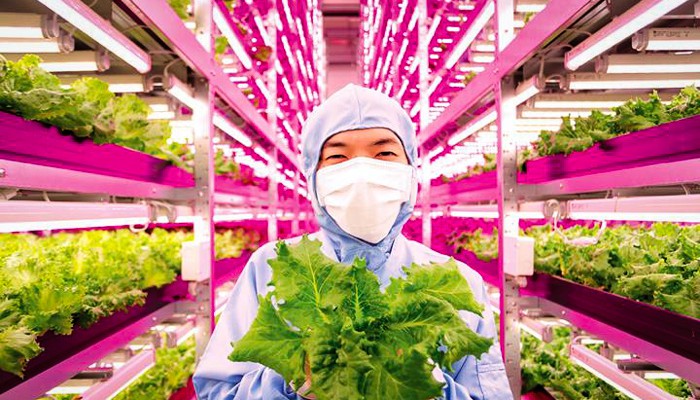BY: DANIEL KORN
Food shortage is a bigger problem than a lot of people realize. At the current growth rate of 1.1% a year, the population will see a 30 per cent increase by 2050. That means there has to be a whopping 70 per cent increase in food to meet demand, which, based on the current growth of the agricultural industry, simply isn’t going to happen. Considering that an estimated one-in-eight people worldwide are already suffering from chronic malnourishment, you can see how the problem will get worse over time.
A new indoor farm in Miyagi Prefecture, Japan, created as a joint venture by GE Japan and Mirai Inc. might just be the solution to our grim future. Born out of the 2011 earthquake and tsunami that caused heavy food shortages, the farm is converted from a Sony Corporation semiconductor factory and is half the size of a football field. The indoor farm is illuminated entirely by LEDs and the lights are tailored to the specific frequency of light that plants need, thereby helping the crops grow 2.5 times faster.
 Meanwhile, the indoor aspect means that the farmers have complete control over the conditions of their produce, are able to shorten the day/night cycle and can optimize the temperature and humidity. And, perhaps more importantly, they don’t have to deal with natural disasters, droughts, or the off-season. It also means that areas where field farming isn’t possible are now able to grow their own food.
Meanwhile, the indoor aspect means that the farmers have complete control over the conditions of their produce, are able to shorten the day/night cycle and can optimize the temperature and humidity. And, perhaps more importantly, they don’t have to deal with natural disasters, droughts, or the off-season. It also means that areas where field farming isn’t possible are now able to grow their own food.
Is it unnatural? Maybe, but you can’t argue with the results. Since July 2014, the farm has been able to produce 10,000 heads of lettuce a day with 40% less power, 80% less food waste, and 99% less water usage than an outdoor farm. The project has been so effective that there are now plans to build indoor farms in Hong Kong, Russia, and central China. GE and Mirai aren’t the only companies running indoor farms either – Phillips partnered with GreenSense Farms for a project in Indiana, and while the produce is not yet widely available, residents can get produce from the farm directly.
 Indeed, it seems like the only negative aspect to the process is the damage it will do to the traditional farming industry, where I speculate farmers will be unable to keep up with indoor technology. As technology continues to improve and the population continues to swell, it seems the gap between farms and laboratories will continue to shrink.
Indeed, it seems like the only negative aspect to the process is the damage it will do to the traditional farming industry, where I speculate farmers will be unable to keep up with indoor technology. As technology continues to improve and the population continues to swell, it seems the gap between farms and laboratories will continue to shrink.
Sources: xcitefun.net, tumblr.com, innoplex-agri.org

